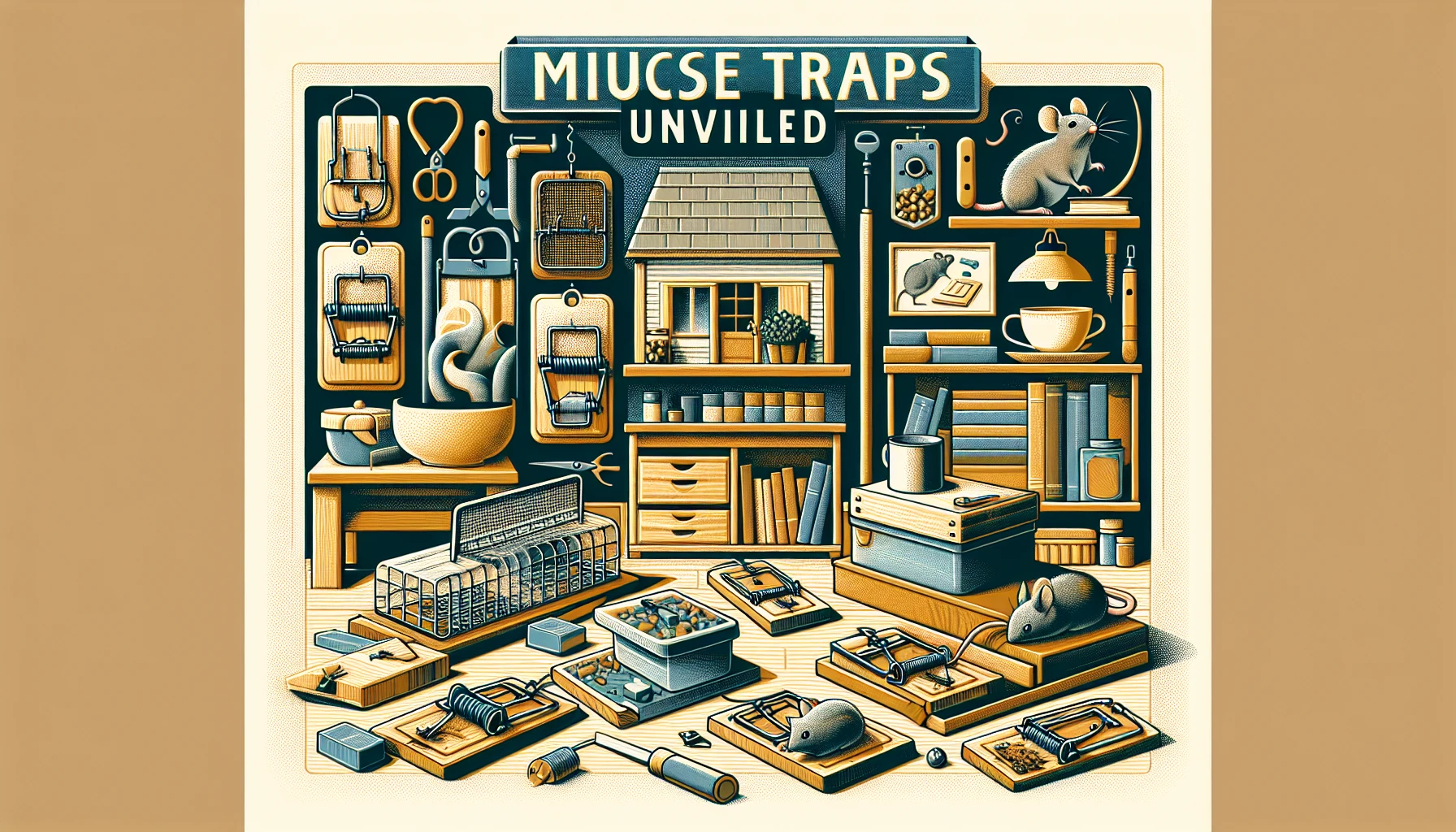Mice Traps Unveiled: Effective Strategies for a Rodent-Free Home
Mice Traps Unveiled: Introduction
Imagine the feeling of unease when you first spot that unmistakable sign of a rodent visitor—a nibbled piece of bread left out on the counter or the faint pitter-patter in the walls as night falls. Mice, arguably unwelcome guests in our homes, not only bring about discomfort but can also pose significant health risks. It’s crucial for any homeowner to understand the importance of controlling these tiny intruders. But fear not! We’re here to pull the curtain back on the world of mice traps, shining a light on the most effective strategies that promise a rodent-free home.
From the good old-fashioned snap trap to ultrasonic pest repellers, the market brims with solutions. Yet, not all traps are created equal. Some deliver instant outcomes with a sound you can’t mistake, while others work in silence, concealing the captured critter. Let’s not forget those innovative catch-and-release options, allowing for a more humane approach to pest control. As we embark on this journey through various traps types, their pros and cons will come to light, helping you to determine which device matches your creed and need for a peaceful abode.
Real-life scenarios bring these tools to life. Consider the city dweller who lays down a line of sticky traps, only to find them as empty as a deserted alley—or perhaps you’ve heard whispers from the suburban family, who swears by their electronic traps, nodding in approval as their mouse woes dwindle. It’s these stories, grounded in the day-to-day battles with these persistent pests, that underscore the quest for an effective mice trap solution.
And so, armed with knowledge and ready to deploy the right trap, homeowners like you can look forward to reclaiming your sanctuary. Stay tuned as we delve deeper into the mechanics and cunning strategies behind the traps that stand guard while you sleep, ensuring that the only guests who stay over are the ones you actually invite.

Understanding Mice Behavior
Ever wondered what goes on in the mind of a mouse? These tiny creatures are more than just pesky invaders; they have habits and habitats that, if understood, can be the key to outsmarting them for a rodent-free home. Let’s dive into their world and uncover some fascinating insights that might just be the ‘cheese’ to our trap!
Mice are survival artists, adept in the fine art of sneaking around. They love cozy spaces where they can nest, like that old pile of clothes you’ve been meaning to donate or the attic insulation you haven’t checked since last Christmas. And if you thought your midnight snack was a secret, think again! Crumbs and scraps are like a treasure map leading them right to your pantry. But it’s not just about food; warmth and safety are their priorities—especially during those chilly nights.

Picture this: It’s wintertime, and the temperature outside is dropping faster than the last leaves of autumn. The mice outside sense the warmth seeping through the cracks of your home. It’s an open invitation! They’ll squirm through spaces as small as a dime to enter the realm of endless buffets and plush accommodations (your home, that is!).
Now, understanding this behavior lets us strategize effectively. Sealing up those tiny entrances and keeping a tidier kitchen are just the starters. Don’t rely on luck; implement thorough rodent prevention tactics to keep your home a no-mouse zone. You might not spot them during the day—mice are nocturnal after all. It’s during the quiet night that they scurry about, so listen for those tell-tale signs: the scratching, nibbling, and rustling through the dark.
Remember, it’s not just about setting traps willy-nilly. It’s about strategic placement and using their behavior patterns against them. Think like a mouse, act like a savvy homeowner, and you’ll have a foolproof plan for ensuring those traps aren’t just decorative. There’s an art to this, and with a little extra knowledge, your trap setup can be a masterpiece of mouse deterrence.
Types of Mice Traps Available
If you’ve ever dealt with an uninvited rodent guest, you know that the right mousetrap can make all the difference. Let’s break down the options and figure out which trap could be the MVP in your quest for a rodent-free home.
Snap Traps: The Classic Quick Fix
When you think of mice traps, the snap trap probably comes to mind first. It’s a tried-and-true method that’s been around for ages, and for a good reason: it works. Sporting a spring-loaded bar that does the dirty work, these traps are known for their effectiveness. However, let’s be real – handling them can be a bit unsettling, and they aren’t exactly the most humane option.
Electronic Traps: High-Tech Rodent Control
For those who prefer a more modern approach, electronic traps are the tech-savvy cousins of the traditional snap trap. They lure mice in with bait and then deliver a lethal electric shock. They’re quick, clean, and you don’t have to see the aftermath – the trap takes care of that for you. Just remember, keeping them powered up is essential, so you’ll need to check the batteries periodically.
Live Catch Traps: The Compassionate Alternative
Not everyone wants to end Mickey’s life, and live catch traps cater to the more humane side of the situation. These traps allow you to catch and release the mice without causing them harm. Sounds perfect, right? Just keep in mind that you’ll need to release them far enough from your abode, or they might just beat you back to your doorstep!
Glue Traps: Sticky and Tricky
The last on our list is the glue trap. Simplicity is its superpower – laying down a sticky pad that rodents can’t escape from. While they’re undeniably effective and convenient, they can be a bit grim, both to the mice and the person discovering the trapped critter. So consider your stomach for such things before going the adhesive route.
Whichever trap you choose, remember the goal is to outsmart these clever creatures without turning your home into a horror show. Check out this video that delves into some of the traps we discussed and might give you some creative ideas to tackle your rodent woes:
Armed with this knowledge, you’re on your way to a more peaceful, rodent-free dwelling. Choose wisely and may the odds be ever in your favor!
Choosing the Right Trap for Your Needs
Embarking on the quest to find the ideal mice trap for your home can be like navigating a maze—pun intended. It’s not simply a matter of picking the ‘best’ trap; it’s about finding the right trap that aligns with your unique situation. Whether you’re dealing with a single, sneaky critter or facing an army of tiny cheese-lovers, let’s dive into what makes a trap not just good, but great for you.
Firstly, consider the infestation level. If you’ve only spotted signs of a lone mouse, a simple solution like a classic snap trap may do the trick. However, for more significant intrusions, you might need to amp up your strategy with multiple traps or even electronic ones that can handle a high volume of unwanted visitors. Just remember to check these regularly, as an overcrowded trap could become a horror story of its own!

Next, let’s talk location. It’s all about real estate, isn’t it? Placing traps in hotspots where mice frequent—think near walls, behind appliances, or in dark nooks—can exponentially increase your success rate. Stealthy as mice may be, they leave clues. Track these patterns to strategically position your traps. After all, it’s not just about having the right tool; it’s about setting the stage for capture.
Lastly, the humane considerations. Not everyone is comfortable with the ‘snap’ and the cleanup that follows. For the tender-hearted or those seeking a no-kill approach, humane traps are the unsung heroes. These clever devices allow you to catch your tiny houseguests and release them into the wild, far away from your pantry. Intrigued? You can take a gander at some of the most praised humane traps and see what aligns with your moral compass.
Choosing the right mice trap means balancing effectiveness with personal ethics and practicality. Take a moment to assess your situation, consider your options, and then set the stage for a rodent-free abode. With a bit of strategy and the right tools, you’ll be on your way to reclaiming your peaceful, furry critter-free home.
Placement and Baiting Strategies for Effective Mice Control
Victorious mouse trapping isn’t just about the trap you choose; it’s also about where you place it and what savory treats you use as bait to lure those pesky rodents in. Let’s dive into the nitty-gritty of turning your living space into a no-go zone for mice, ensuring they can’t nibble their way through your home.
Location Is Key
First thing’s first: mice aren’t big on open spaces. They’re edge creatures, scurrying along walls, tucked away in clutter, or snaking through hidden crevices. Observe their pathways and position your traps along these mouse highways. Behind appliances, inside cabinets, or along baseboards are prime real estate for your mouse trap setup.
Understanding Mouse Psychology
Mice are naturally curious but also incredibly wary of new objects in their path. Give them time to get acquainted with the trap. Leave it baited but unset for a few nights. Once they’ve treated the trap like a free takeout joint, it’s time to set the stage for capture.

The Bait Debate: What’s on the Menu?
Forget the myth that cheese is the mouse delicacy of choice. In reality, high-protein substances like peanut butter or chocolate are more enticing. These spreads also stick to the trap, making it harder for our four-legged intruders to make a clean getaway with the bait. For a gourmet twist, try nesting a few seeds or nuts in the peanut butter—it’s like offering an irresistible mouse tapas. And if you’re dealing with particularly savvy mice, soft nesting materials like cotton balls can also be a hit since they’re always on the lookout for cozy materials for their dens.
By strategically placing and baiting your traps, you’ll transform your home from a mouse haven to a rodent-free fortress. Remember, the goal is to entice and capture, so be patient and persistent with your efforts. Before long, you’ll have the upper hand in this little game of cat and mouse—sans the cat!
Safety Considerations for Household and Pets
When it comes to keeping our homes rodent-free, the first thing that comes to mind is often mice traps. However, alongside the satisfaction of knowing your mouse problem is being handled, there’s a critical piece of the puzzle that must not be overlooked: safety. For families and four-legged friends alike, the improper use of traps can present unforeseen dangers. So, let’s discuss how to make your mouse-trapping efforts both effective and safe.
Think of little Jimmy or your furry companion, Whiskers, making their daily rounds through the house. The last thing we want is either to encounter a problematic trap scenario. Proper placement of mice traps is paramount. You wouldn’t lay down an obstacle course where they play or nap, right? Well, traps are no different. Consider areas less frequented by children and pets, such as behind appliances, inside lower cabinets with child-proof locks, or in the garage – places where mice scurry but kiddos and pets don’t.
It’s not just about placing traps out of reach; it’s also about choosing the right kind of trap. Some traps are designed with safety in mind, featuring enclosures that conceal the trapped rodent and reduce contact with the trap mechanism itself. This way, your pets won’t mistake them for a plaything, and tiny hands won’t find their way to danger.
Handling of traps is another area requiring careful attention. Always wear gloves – not just for hygiene but to keep your scent off the traps (mice are wily and can detect your presence, making the trap less effective). And once a mouse is caught, proper disposal is key. Show your children the respect you have for the traps, impressing upon them that these are not toys but tools that keep the household clean and disease-free.
For more insights into keeping your space sanitary and how to manage any unexpected encounters with rodents, consider reading about effective rodent control techniques. There, you’ll find a treasure trove of information.
In conclusion, ensuring the safety of everyone in your home while using mice traps isn’t just a good practice – it’s a necessity. With proper placement, handling, and a bit of know-how, your house can become a no-mouse zone while keeping everyone from becoming unintended victims in the quest for a rodent-free home.
Cleaning Up After Capturing Mice
So, you’ve declared war on those pesky rodents and laid out the traps. Victory! But what’s this? The aftermath looks like a crime scene from “Rodent CSI,” and now you’re tasked with cleanup duty. Fear not, brave homeowner, because this guide is here to turn you into a clean-up ninja, swift and efficient.
First things first, let’s address the captured critters. You’ll want to don a pair of heavy-duty gloves for this operation—think less “fancy dinner party” and more “nuclear waste handling.” Safely remove the mouse from the trap and wrap it in a newspaper, giving it a little mousy mummy makeover. Now, bid farewell as you place it in a sealed bag and into the trash. It may feel like a solemn moment, so feel free to say a few words if the mood strikes.

After the mouse has been respectfully disposed of, it’s time to tackle the crime scene. Get your trusty disinfectant and spray the area like you’re marking your territory. (Okay, maybe don’t take that analogy literally.) Let it sit for a few minutes; patience is a virtue, after all. While you wait, you might ponder life’s mysteries or do a quick spot of meditation.
Now, grab a paper towel and wipe the area with the precision of a surgeon—or a toddler with a crayon, no judgment here. Ensure that all traces of the mousey encounter are wiped clean. Remember, rodents can carry diseases, so this step isn’t just about aesthetics; it’s about keeping you and your family safe.
As an added measure, why not absorb some additional knowledge on preventive pest control to avoid future uninvited guests?
Finally, scrutinize the room like Sherlock Holmes at a crime scene. Check under furniture, inside cabinets, and don’t forget the tucked-away nooks where mice love to party. Once you’re sure the area is spotless and the disinfectant has dried, take a deep breath (through your mouth, just in case) and enjoy your rodent-free space.
Prevention: Stopping Mice Before They Enter
When it comes to keeping your home free from the scurrying nuisance of mice, prevention is your best strategy. It’s not enough to set traps; you must turn your residence into a fortress against these tiny invaders. Let’s dive into the measures you can take to seal your castle from unwanted furry guests.
Seal the Gates: Entry Point Fortification
Start by conducting a meticulous inspection of your home. Mice are masters of squeezing through the tiniest of cracks. Imagine you’re a mouse, eyeing up your home with the intent of making it your own. Check for gaps or holes, and remember, if a pencil can slide through, a mouse can squeeze through! Use durable materials such as steel wool and caulk to seal openings in walls, near pipes, and around windows and doors. Especially focus on those low-lying areas; mice aren’t frequent flyers, so ground-level vulnerabilities are their preferred entry points.
Reduce the Allure: Minimize Attractants
Our homes are full of enticing aromas and delectables that are irresistible to mice. It’s like an all-you-can-eat buffet; the trick is to shut it down. Make sure all food is stored in airtight containers. This includes pet food, which often goes unnoticed as a mouse magnet. Keep your space tidy—crumbs are a feast for a mouse! Regularly take out the garbage and ensure bins have tight-fitting lids. Good housekeeping isn’t just for show; it’s a critical line of defense against rodent invaders.
Outside, it’s no different. Overgrown vegetation against your home serves as cover for mice to stage their break-in. Keep the shrubbery trimmed and dispose of any debris or clutter near your home. Wood piles? Store them securely and away from your house’s foundation. Remember, if you’re providing a mouse with a hideout, you’re rolling out the welcome mat.
It’s not just what’s on the inside that counts. Your extermination efforts should extend to the great outdoors. Strategic landscaping can deter mice. For example, peppermint plants are known to be a natural deterrent. And while you’re sprucing up the garden, consider installing a gravel or stone perimeter around your home. It’s like mouse quicksand, they really dislike scampering over such unstable terrain.
While these steps won’t entirely guarantee a mouse-free home, they significantly lower the odds of an infestation. Stay vigilant and maintain these preventative practices to provide ongoing protection for your home, making it less of a target for those pesky rodents. Remember, the best offense against mice is a great defense.
Professional Versus DIY Mice Control
When it comes to ridding our homes of the scurrying menace that is mice, homeowners are often caught in a dilemma: should you call in the pros or can you take matters into your own hands? This pivotal decision can feel like you’re standing at a crossroad, with peace of mind on one side and a potential DIY disaster on the other. Let’s break it down together, shall we?
Enlisting professional rodent control services comes with the assurance of experience and expertise. These folks are the Navy SEALs of pest eradication; they’ve seen it all, trapped it all, and sent these tiny invaders packing time and time again. They come armed with an arsenal of traps, baits, and insider know-how that can only be gleaned from years in the trenches of the vermin battlefield.
Example A: Imagine Jane Doe and her recurring mouse melodrama. Every autumn, like clockwork, the pitter-patter of little feet announced the arrival of uninvited guests in her walls. Exasperated, Jane tried every trick in the book, each as ineffective as the last. Finally, she called in the professionals. They swooped in, fortified her fortress, and voila, the MOUSEcalypse was averted!
Going DIY: A Brave New World?
Now, let’s pivot to the burgeoning sector of DIY mice control. It’s a brave new world out there, filled with Youtube tutorials, blog posts, and enough hackneyed tips to fill a novella. The appeal? Cost efficiency, and the satisfaction of taking on the tiny beasties toe-to-toe (or, should we say, trap-to-tail?). The homemade traps, the strategic placement of peppermint oil, the thrill of victory! Or, so the story goes…
But heed this friendly advice: DIY isn’t always as easy as pie. It’s not just about setting a trap and waiting for the ‘snap,’ it’s about understanding the wily nature of your adversary. Where do they scurry? What do they nibble? And most crucially, what’s the endgame for ensuring they don’t simply saunter back in once you’ve declared victory?
Diving into DIY rodent control, terrific advice is just a click away, offering safe and effective techniques that’ll have you high-fiving in rodent-free revelry—if done correctly. Just remember, while some have found their DIY stride and tread confidently on the path of pest liberation, others might find themselves outwitted at their own game. It’s like the mice are chuckling in the shadows, whispering, “Nice try, human.”

In the end, whether you opt for the professional cavalry or don your DIY armor, the goal is the same: a home that’s a no-mouse zone. Evaluate the scale of your rodent conundrum, weigh the pros against the cons, and choose your weapons wisely. May the best mouse-catcher win!
Frequently Asked Questions
When it comes to ousting those pesky rodents from your abode, having a clear battle plan and the right tools are paramount. The efficacy of the humble mouse trap often comes under scrutiny—does it deliver the promised rodent-free existence, or is it just an old wives’ tale resume in the making? Well, let’s break down the intelligence we’ve gathered from the field.

How effective are traditional mice traps?
In the game of mouse and man, never underestimate classic snap traps. They have stood the test of time for a reason—they work! When placed strategically along the skirting boards where the critters scuttle, or in the shadowy corners of pantry battlegrounds, they can put an end to Mickey and his platoon with a swift blow. Yet, like any tactic, success lies in the execution. A misplaced trap is as good as a white flag. Imagine that: a cheese banquet uncrashed!
What are some non-toxic solutions for capturing mice?
For those with a green heart and a soft spot for furry trespassers, fear not. The market brims with contraptions that catch but don’t kill. Take, for example, the live-catch trap. It’s like a miniature, non-lethal Alcatraz for rodents. Baiting with peanut butter—a delicacy no mouse can resist—you can transport your furry captive to a distant field, negotiating their release back into the wild. The success rate? Paramount, provided you don’t become a repeat offender by letting them out in your backyard.
Best practices for baiting and placement of mice traps?
Picture this: you’ve set the scene with tantalizing bait—a dollop of nutty spread or a morsel of chocolate. However, placement is just as crucial as the bait itself. The golden rule? Tracking their tiny footprints to their secret rendezvous points. Always anchor your traps near walls as mice, being the skittish creatures they are, avoid open space duels. Additionally, gloves are must-have gear when handling traps. Your human scent is a glaring red light to a mouse. Infiltrate their defenses with an invisible presence, and victory shall be yours!








